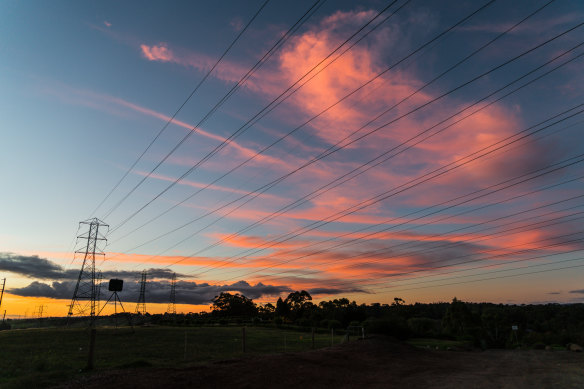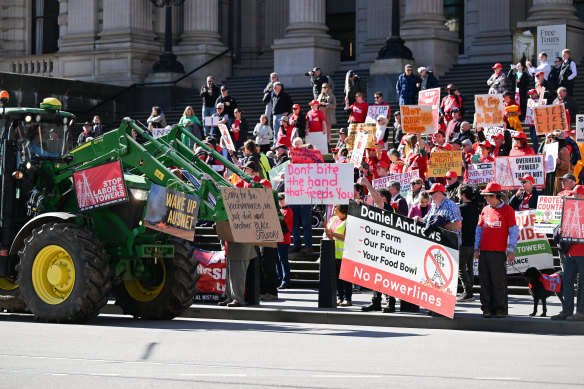Save articles for later
Add articles to your saved list and come back to them any time.
A continuation of delays and disruptions to new energy projects will impose perilous risks of power outages as soon as the coming summer, amid escalating closures of ageing coal-fired power plants and unexpected blowouts to the deadline and cost of the Snowy 2.0 pumped hydro scheme.
The independent energy grid operator said state and federal government schemes to encourage investment in preparing the grid for its transition to clean energy, coupled with private projects under development, should be enough to prevent blackouts if all goes to plan.
The Victorian and NSW governments are nervous about energy security and the risks of blackouts as the grid is weaned off fossil fuels.Credit: Getty Images
However, the Australian Energy Market Operator (AEMO) said in its annual Economic Statement of Opportunities report that delays to any projects “have the potential to result in periods of high risk throughout the 10-year horizon”. The report is designed to send an investment signal to the energy market to spur new projects where needed.
This is an ominous warning targeted at state and federal governments, following frequent setbacks on a number of critical energy projects.
The electricity market’s reliability standard requires at least 99.9994 per cent of forecast customer demand to be met each year. Under this test, Victoria and South Australia are forecast to breach the standard this summer, followed by NSW in 2025 when the Eraring coal plant is set to shut, and Queensland in 2029.
However, AEMO’s forecast is based on a conservative threshold that considers only projects with fully committed funding. Chief executive Daniel Westerman stressed there are a plethora of proposed projects with a total generation potential that far outweighs that of the east coast grid’s 65 gigawatt generation capacity.
“While our central scenario shows increased reliability risk, it does not reflect the reliability potential from the 248-gigawatt pipeline of proposed generation and storage projects, actionable transmission projects and government energy programs under way,” he said.
The Victorian and NSW governments are nervous about energy security and the risks of blackouts as the grid is weaned off fossil fuels, with coal plants closing at a rapid rate as cheaper renewables come on the market.
Victoria has committed taxpayers’ dollars to cover the potential costs of keeping two of its largest coal plants operating until their expected closure dates, and NSW is considering subsidising Eraring, its biggest coal power plant.
Some of the largest projects to back up renewables with dispatchable energy include the Snowy 2.0 project, which has been delayed from its initial deadline of 2021 to 2029 and blown out from its initial $2 billion price tag to $12 billion and the Battery of the Nation project.
Farmers from the Victoria’s Western District rally on the steps of the state parliament, protesting against transmission lines being built on their properties. Credit: Joe Armao
That project is reliant on connecting the eastern seaboard grid to Tasmania’s hydropower via the Marinus Link, an undersea cable to Victoria, which has blown out in cost by an estimated $1 billion during the past year to a price tag of $4 billion.
Transmission projects are also mired in fights with local communities and the resulting delays are a major headache for the clean energy transition, with the extra power lines needed to link new wind and solar farms in the bush to cities.
Climate Change and Energy Minister Chris Bowen said AEMO had warned of power shortfalls for more than five years and blamed the former Coalition government for failure to upgrade the grid to handle the shift to renewables and increased demand from population growth.
“We’ve had four gigawatts of dispatchable energy leave the grid over the last decade and only one gigawatt come on,” Bowen said.
AEMO’s findings backed the federal government’s initiatives and highlighted the demand for government support, such as a $20 billion fund to underwrite private transmission projects and a Capacity Investment Scheme, he said.
Federal and state governments are running competitive tender processes, seeking bids for priority renewable energy and storage projects to replace fossil fuels, such as wind and solar farms and batteries.
Bowen launched a competitive tender under the scheme in Victoria and South Australia on Wednesday, which will start taking bids in October.
Cut through the noise of federal politics with news, views and expert analysis from Jacqueline Maley. Subscribers can sign up to our weekly Inside Politics newsletter here.
Most Viewed in Politics
From our partners
Source: Read Full Article




